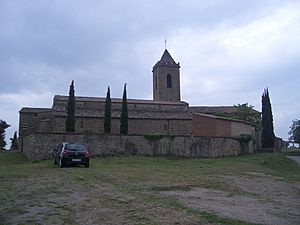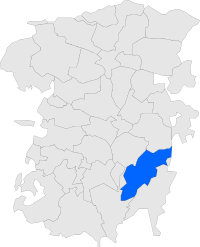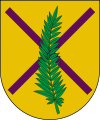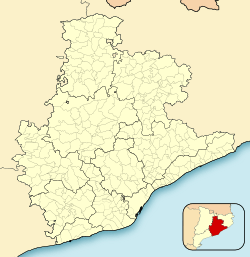Sagàs facts for kids
Quick facts for kids
Sagàs
|
||
|---|---|---|
|
Municipality
|
||

Church of Sant Andreu.
|
||
|
||

Location in Berguedà
|
||
| Country | ||
| Community | ||
| Province | Barcelona | |
| Comarca | Berguedà | |
| Area | ||
| • Total | 44.6 km2 (17.2 sq mi) | |
| Elevation | 738 m (2,421 ft) | |
| Population
(2018)
|
||
| • Total | 161 | |
| • Density | 3.610/km2 (9.35/sq mi) | |
| Demonym(s) | Saganès | |
Sagàs is a small town and a type of local government area called a municipality in Catalonia, Spain. It is located in a region known as Berguedà, near the Pyrenees mountains.
Contents
What is Sagàs Like?
Sagàs is mostly made up of farmhouses, called masies, spread out among low wooded hills and cultivated fields. The municipality includes five small villages: Sant Andreu de Sagàs, El Carrer de Bonaire, Biure de Berguedà, La Guàrdia de Sagàs, and Valloriola. It also has two church areas, called parishes: Sant Andreu de Sagàs and Santa Maria de la Guàrdia.
How Do People Live in Sagàs?
For a long time, most people in Sagàs made their living from farming. While farming is still important, new machines have changed how farms work. This has led to more people visiting for rural tourism. The population has also decreased a bit over time.
What Does the Sagàs Coat of Arms Look Like?
Sagàs does not have an official coat of arms recognized by the government of Catalonia. However, the town hall traditionally uses a yellow shield. On the shield, there is a purple "X" shape, which is called a saltire cross. It also has a palm branch, which is a symbol for Saint Andrew.
What Celebrations Happen in Sagàs?
Sagàs has several special celebrations throughout the year.
When is the Main Town Festival?
The main town festival, called the festa major, happens on November 30th. This day celebrates the town's patron saint, Saint Andrew.
Are There Other Festivals?
Yes, the parish of La Guàrdia de Sagàs has its own celebration on the first Sunday of October. The town hall also often organizes a "community supper," called a sopar de germanor. This usually happens around October 16th, which is the feast day of Saint Gaudericus. He is the patron saint of Catalan farmers.
What Are the Main Sights to See in Sagàs?
Sagàs has several interesting historical buildings and places to visit.
- Church of Sant Andreu (Saint Andrew): This church has been around since the 11th century. The current building was built in the Romanesque style. It has a typical design with three long sections, called naves, each ending in a round shape. The church was changed a lot in the 15th century, including adding the bell-tower you see today. The altar inside is also very famous. Starting in 1970, local people worked to restore the church to look more like its original 11th-century design. Today, it is fully restored.
- Church of Sant Esteve de Valldoriola
- Chapel of Santa Margarida de Sagàs: This small chapel was built in the 10th century or even earlier.
- Chapel of Sant Jordi: A small chapel dedicated to Saint George.
- Church of Sant Martí de Biure: This is another Romanesque church from the 10th century.
- Church of Santa Maria de la Guàrdia: This church has a famous statue of the Virgin Mary. It is located on a hill overlooking the Llobregat valley and is well-known for its amazing views.
- Ruins of the Tower of Sagàs: These are the remains of a small fortress from the 5th century.
What is the History of Sagàs?
Sagàs has a long and interesting history, going back thousands of years.
Who Lived in Sagàs Long Ago?
Before the Romans arrived, the area of Sagàs was home to an Iberian tribe called the Bergistani. A Roman historian named Livy wrote about a city called Segestica, which was "important and rich." Most people believe he was talking about Sagàs.
Livy wrote that a Roman leader, Cato the Elder, ordered the walls of all Iberian towns to be taken down. This was to prevent more rebellions. Only Segestica resisted and had to be captured by force. The importance of this ancient city helps explain why there are many old place names around Sagàs that are not from Latin.
How Did Sagàs Develop in Medieval Times?
The first written record of Sagàs is from the year 903. It describes the official blessing of the Church of Sant Andreu. This was done by the Bishop of Urgell because local people had built the church. The document says the church was "in Bergan territory, at a place called Sagasse." The current Church of Sant Andreu was built later, on the same spot. Not much is left of the very first church, but thirteen graves from its old cemetery have been found inside the current church.
Sagàs was first part of the County of Osona. Then, in the 10th century, it became part of the County of Berga, which later joined the County of Cerdanya. During the 11th century, a monastery called Sant Pere de la Portella bought a lot of land in Sagàs. For much of the Middle Ages, Sagàs was ruled by the Barons of la Portella, but it later became part of the Barony of Pinós.
It seems that Sagàs has always been a farming town and was not very important for military reasons. However, a small castle, about three meters by six meters at its base, was built there between the tenth and twelfth centuries.
What Happened in More Recent Times?
In 1994, Sagàs was badly affected by wildfires. These fires burned a large part of the regions of Berguedà and Bages. Much of the forest around the town was lost, and the local farms were also seriously damaged.
See also
 In Spanish: Sagás para niños
In Spanish: Sagás para niños




